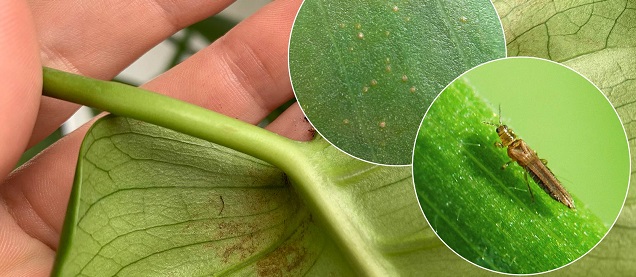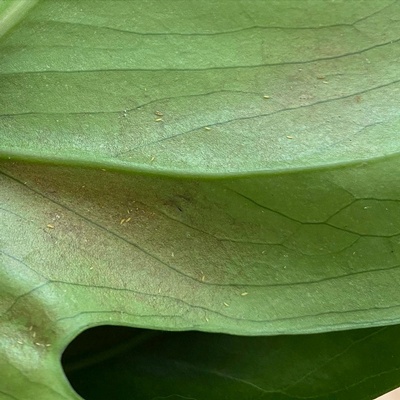
Thrips: The Sneaky Intruders of the Plant World
Ah, thrips – those tiny troublemakers that seem to sparkle like flecks of glitter in the plant realm. Pervasive, persistent, and undoubtedly pesky, these minuscule pests pose quite the challenge for gardeners. But fear not, for with a bit of effort, they can be managed effectively.

Unraveling the Mystery of Thrips
Thrips, those elusive insects, often evade detection with their minuscule size and subtle appearance. These cream-colored or black creatures may go unnoticed until their damage becomes apparent. Look for leaves that appear dull or tarnished, and keep an eye out for new growth that seems deformed – these are telltale signs of a thrips infestation. Their preference for the tender undersides of leaves and fresh growth makes them particularly tricky to spot.
Thrips doing thrips stuff. Notice the droplet of excrement it leaves behind. These little black spots are one of the ways to identify a thrips infestation. Video by Lauren Sottile
The Wandering Ways of Thrips
How do thrips find their way into our gardens? Well, it's all in the wind. Equipped with wings but notoriously poor fliers, thrips hitch rides on gentle breezes, infiltrating our sanctuaries through open windows or hitching a ride on clothing. Their prevalence is more pronounced in warmer climates, as they struggle to survive harsh winters. Beware, for they can also sneak into our homes through unsuspecting carriers like flower bouquets or even fruits and vegetables, evading our vigilant gaze until it's too late.
The Challenge of Treatment
Treating thrips is like solving a puzzle, thanks to their complex life cycle. With three distinct stages – egg, nymph, and adult – thrips exhibit remarkable resilience and reproductive prowess. Eggs laid within leaf tissues hatch into nymphs within days, swiftly maturing into adults capable of perpetuating the cycle with alarming speed. The challenge lies not only in eradicating the visible pests but also in tackling the concealed eggs, ensuring no stone is left unturned in our battle against these cunning invaders.
A Strategic Approach to Treatment
Step 1: Isolation and Vigilance Begin by isolating the affected plant to prevent the spread of thrips to neighboring greenery. Assume a proactive stance by treating nearby plants preemptively, as they may also harbor thrips.
Step 2: Thorough Cleansing Shower or bathe the infested plant with lukewarm water and a gentle soap solution, ensuring thorough coverage of all surfaces. Pay special attention to the undersides of leaves and stems, where thrips often lurk.
Step 3: Tactical Treatment For larger plants or those impractical to move, consider using insecticidal sprays formulated to combat thrips. Apply these treatments diligently, targeting emerged thrips rather than their hidden eggs, and repeat as needed to break the cycle of infestation.
The Art of Prevention
Prevention is indeed worth a pound of cure, especially when it comes to thrips management. Adopt a hyper-vigilant approach to safeguarding your green companions:
- Inspect flower bouquets and produce, keeping them separate from your plants.
- Exercise caution when acquiring new additions to your botanical family, subjecting them to a quarantine period before integration.
- Make routine inspection of houseplants a habit, arming yourself with insecticidal products as a preemptive measure.
- Remember, there's no shame in parting ways with a plant overwhelmed by thrips. Act swiftly, for these pests multiply with alarming speed, sparing no time for indecision.
In the intricate tapestry of garden care, thrips stand as a formidable adversary, testing the resolve and resourcefulness of even the most seasoned gardener. Yet armed with knowledge, diligence, and a touch of foresight, we can rise to the challenge, preserving the vitality and beauty of our green sanctuaries.



